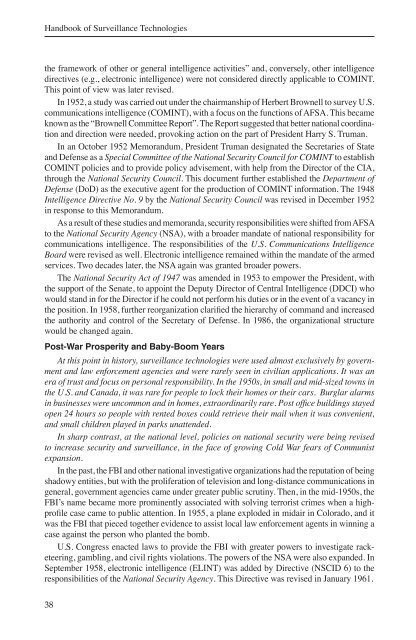Handbook of Surveillance Technologies (3rd Ed) - The Real Faces of ...
Handbook of Surveillance Technologies (3rd Ed) - The Real Faces of ...
Handbook of Surveillance Technologies (3rd Ed) - The Real Faces of ...
Create successful ePaper yourself
Turn your PDF publications into a flip-book with our unique Google optimized e-Paper software.
<strong>Handbook</strong> <strong>of</strong> <strong>Surveillance</strong> <strong>Technologies</strong><br />
the framework <strong>of</strong> other or general intelligence activities” and, conversely, other intelligence<br />
directives (e.g., electronic intelligence) were not considered directly applicable to COMINT.<br />
This point <strong>of</strong> view was later revised.<br />
In 1952, a study was carried out under the chairmanship <strong>of</strong> Herbert Brownell to survey U.S.<br />
communications intelligence (COMINT), with a focus on the functions <strong>of</strong> AFSA. This became<br />
known as the “Brownell Committee Report”. <strong>The</strong> Report suggested that better national coordination<br />
and direction were needed, provoking action on the part <strong>of</strong> President Harry S. Truman.<br />
In an October 1952 Memorandum, President Truman designated the Secretaries <strong>of</strong> State<br />
and Defense as a Special Committee <strong>of</strong> the National Security Council for COMINT to establish<br />
COMINT policies and to provide policy advisement, with help from the Director <strong>of</strong> the CIA,<br />
through the National Security Council. This document further established the Department <strong>of</strong><br />
Defense (DoD) as the executive agent for the production <strong>of</strong> COMINT information. <strong>The</strong> 1948<br />
Intelligence Directive No. 9 by the National Security Council was revised in December 1952<br />
in response to this Memorandum.<br />
As a result <strong>of</strong> these studies and memoranda, security responsibilities were shifted from AFSA<br />
to the National Security Agency (NSA), with a broader mandate <strong>of</strong> national responsibility for<br />
communications intelligence. <strong>The</strong> responsibilities <strong>of</strong> the U.S. Communications Intelligence<br />
Board were revised as well. Electronic intelligence remained within the mandate <strong>of</strong> the armed<br />
services. Two decades later, the NSA again was granted broader powers.<br />
<strong>The</strong> National Security Act <strong>of</strong> 1947 was amended in 1953 to empower the President, with<br />
the support <strong>of</strong> the Senate, to appoint the Deputy Director <strong>of</strong> Central Intelligence (DDCI) who<br />
would stand in for the Director if he could not perform his duties or in the event <strong>of</strong> a vacancy in<br />
the position. In 1958, further reorganization clarified the hierarchy <strong>of</strong> command and increased<br />
the authority and control <strong>of</strong> the Secretary <strong>of</strong> Defense. In 1986, the organizational structure<br />
would be changed again.<br />
Post-War Prosperity and Baby-Boom Years<br />
At this point in history, surveillance technologies were used almost exclusively by government<br />
and law enforcement agencies and were rarely seen in civilian applications. It was an<br />
era <strong>of</strong> trust and focus on personal responsibility. In the 1950s, in small and mid-sized towns in<br />
the U.S. and Canada, it was rare for people to lock their homes or their cars. Burglar alarms<br />
in businesses were uncommon and in homes, extraordinarily rare. Post <strong>of</strong>fice buildings stayed<br />
open 24 hours so people with rented boxes could retrieve their mail when it was convenient,<br />
and small children played in parks unattended.<br />
In sharp contrast, at the national level, policies on national security were being revised<br />
to increase security and surveillance, in the face <strong>of</strong> growing Cold War fears <strong>of</strong> Communist<br />
expansion.<br />
In the past, the FBI and other national investigative organizations had the reputation <strong>of</strong> being<br />
shadowy entities, but with the proliferation <strong>of</strong> television and long-distance communications in<br />
general, government agencies came under greater public scrutiny. <strong>The</strong>n, in the mid-1950s, the<br />
FBI’s name became more prominently associated with solving terrorist crimes when a highpr<strong>of</strong>ile<br />
case came to public attention. In 1955, a plane exploded in midair in Colorado, and it<br />
was the FBI that pieced together evidence to assist local law enforcement agents in winning a<br />
case against the person who planted the bomb.<br />
U.S. Congress enacted laws to provide the FBI with greater powers to investigate racketeering,<br />
gambling, and civil rights violations. <strong>The</strong> powers <strong>of</strong> the NSA were also expanded. In<br />
September 1958, electronic intelligence (ELINT) was added by Directive (NSCID 6) to the<br />
responsibilities <strong>of</strong> the National Security Agency. This Directive was revised in January 1961.<br />
38



